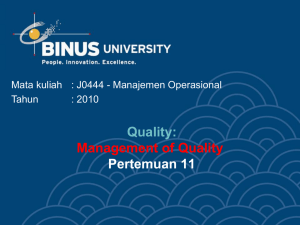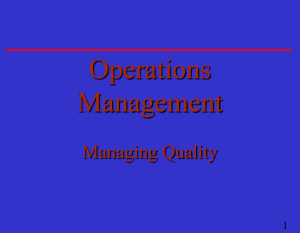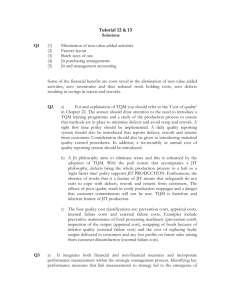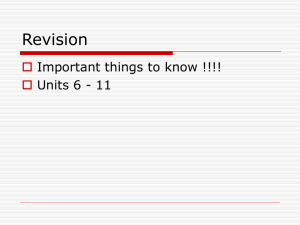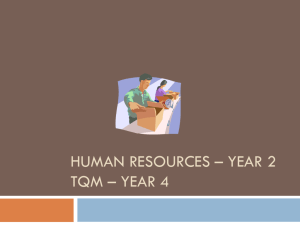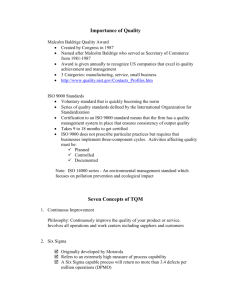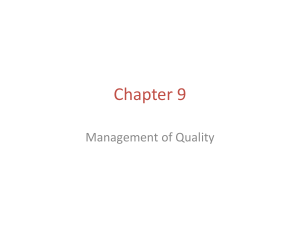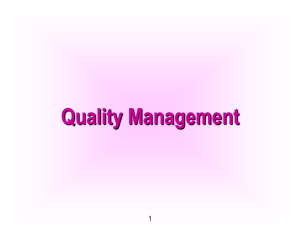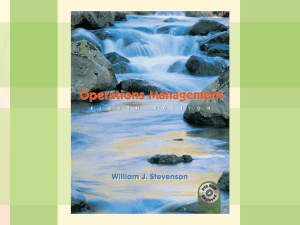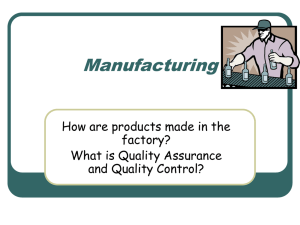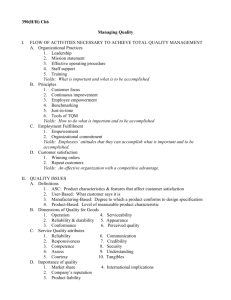POM LECT 8 ver 2
advertisement
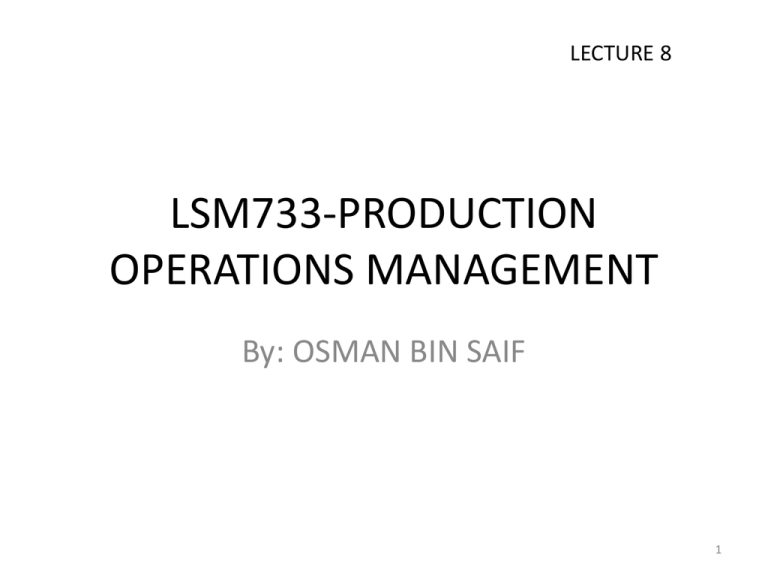
LECTURE 8 LSM733-PRODUCTION OPERATIONS MANAGEMENT By: OSMAN BIN SAIF 1 Summary of last Session Issues for Product Design Robust Design Modular Design Computer-Aided Design (CAD) Computer-Aided Manufacturing (CAM) Virtual Reality Technology Value Analysis Ethics and Environmentally Friendly Design 2 Summary of last Session(Contd.) Time-Based Competition Purchasing Technology by Acquiring a Firm Joint Ventures Alliances Defining a Product Make-or-Buy Decisions Group Technology 3 Summary of last Session(Contd.) Documents For Production Product Life-Cycle Management (PLM) Service Design Documents for Services Application of Decision Trees to Product Design Transition to Production 4 Agenda for this session Global Company Profile: Arnold Palmer Hospital Quality and Strategy Defining Quality Implications of Quality Malcolm Baldrige National Quality Award Cost of Quality (COQ) Ethics and Quality Management 5 Agenda for this session (Contd.) International Quality Standards ISO 9000 ISO14000 6 Agenda for this session (Contd.) Total Quality Management Continuous Improvement Six Sigma Employee Empowerment Benchmarking Just-in-Time (JIT) Taguchi Concepts Knowledge of TQM Tools 7 Managing Quality Provides a Competitive Advantage Arnold Palmer Hospital Deliver over 13,000 babies annually Virtually every type of quality tool is employed Continuous improvement Employee empowerment Benchmarking Just-in-time Quality tools 8 Quality and Strategy Managing quality supports differentiation, low cost, and response strategies Quality helps firms increase sales and reduce costs Building a quality organization is a demanding task 9 Two Ways Quality Improves Profitability Sales Gains via Improved response Flexible pricing Improved reputation Improved Quality Increased Profits Reduced Costs via Increased productivity Lower rework and scrap costs Lower warranty costs Figure 6.1 10 The Flow of Activities Organizational Practices Leadership, Mission statement, Effective operating procedures, Staff support, Training Yields: What is important and what is to be accomplished Quality Principles Customer focus, Continuous improvement, Benchmarking, Just-intime, Tools of TQM Yields: How to do what is important and to be accomplished Employee Fulfillment Empowerment, Organizational commitment Yields: Employee attitudes that can accomplish what is important Figure 6.2 Customer Satisfaction Winning orders, Repeat customers Yields: An effective organization with a competitive advantage 11 Defining Quality The totality of features and characteristics of a product or service that bears on its ability to satisfy stated or implied needs American Society for Quality 12 Different Views User-based – better performance, more features Manufacturing-based – conformance to standards, making it right the first time Product-based – specific and measurable attributes of the product 13 Implications of Quality 1. Company reputation Perception of new products Employment practices Supplier relations 2. Product liability Reduce risk 3. Global implications Improved ability to compete 14 Key Dimensions of Quality Performance Features Reliability Conformance Durability Serviceability Aesthetics Perceived quality Value 15 Malcom Baldrige National Quality Award Established in 1988 by the U.S. government Designed to promote TQM practices Few winners Premier Inc., MESA Products, Sunny Fresh Foods, Park Place Lexus, North Mississippi Medical Center, The Bama Companies, Richland College, Texas Nameplate Company, Inc. 16 Baldrige Criteria Applicants are evaluated on: Categories Points Leadership 120 Strategic Planning 85 Customer & Market Focus 85 Measurement, Analysis, and Knowledge Management 90 Workforce Focus 85 Process Management 85 Results 450 17 Costs of Quality Prevention costs - reducing the potential for defects Appraisal costs - evaluating products, parts, and services Internal failure - producing defective parts or service before delivery External costs - defects discovered after delivery 18 Costs of Quality Total Cost Total Cost External Failure Internal Failure Prevention Appraisal Quality Improvement 19 Leaders in Quality W. Edwards Deming 14 Points for Management Joseph M. Juran Top management commitment, fitness for use Armand Feigenbaum Total Quality Control Philip B. Crosby Quality is Free, zero defects 20 Ethics and Quality Management Operations managers must deliver healthy, safe, quality products and services Poor quality risks injuries, lawsuits, recalls, and regulation Organizations are judged by how they respond to problems All stakeholders much be considered 21 International Quality Standards ISO 9000 series (Europe/EC) Common quality standards for products sold in Europe (even if made in U.S.) 2000 update places greater emphasis on leadership and customer satisfaction ISO 14000 series (Europe/EC) 22 ISO 14000 Environmental Standard Core Elements: Environmental management Auditing Performance evaluation Labeling Life cycle assessment 23 TQM Encompasses entire organization, from supplier to customer Stresses a commitment by management to have a continuing, companywide drive toward excellence in all aspects of products and services that are important to the customer 24 Deming’s Fourteen Points 1. Create consistency of purpose 2. Lead to promote change 3. Build quality into the product; stop depending on inspection 4. Build long-term relationships based on performance, not price 5. Continuously improve product, quality, and service 6. Start training 7. Emphasize leadership Table 6.1 25 Deming’s Fourteen Points 8. 9. 10. 11. 12. 13. Drive out fear Break down barriers between departments Stop haranguing workers Support, help, improve Remove barriers to pride in work Institute a vigorous program of education and self-improvement 14. Put everybody in the company to work on the transformation Table 6.1 26 Seven Concepts of TQM Continuous improvement Six Sigma Employee empowerment Benchmarking Just-in-time (JIT) Taguchi concepts Knowledge of TQM tools 27 Continuous Improvement Represents continual improvement of all processes Involves all operations and work centers including suppliers and customers People, Equipment, Materials, Procedures 28 Shewhart’s PDCA Model 1.Plan Identify the improvement 4. Act and make Implement the a plan plan 3. Check Is the plan working? 2. Do Test the plan Figure 6.3 29 Six Sigma Two meanings Statistical definition of a process that is 99.9997% capable, 3.4 defects per million opportunities (DPMO) A program designed to reduce defects, lower costs, and improve customer satisfaction 30 Six Sigma Two meanings Lower limits Upper limits 2,700 defects/million Statistical definition of a process that is 99.9997% capable, 3.4 defects per 3.4 defects/million million opportunities (DPMO) A program designed to reduce defects, lower costs, and improve customer satisfaction Mean ±3 ±6 Figure 6.4 31 Six Sigma Program Originally developed by Motorola, adopted and enhanced by Honeywell and GE Highly structured approach to process improvement A strategy A discipline - DMAIC 6 32 Six Sigma 1. Define critical outputs and identify gaps for improvement DMAIC Approach 2. Measure the work and collect process data 3. Analyze the data 4. Improve the process 5. Control the new process to make sure new performance is maintained 33 Six Sigma Implementation Emphasize defects per million opportunities as a standard metric Provide extensive training Focus on corporate sponsor support (Champions) Create qualified process improvement experts (Black Belts, Green Belts, etc.) Set stretch objectives This cannot be accomplished without a major commitment from top level management 34 Employee Empowerment Getting employees involved in product and process improvements 85% of quality problems are due to process and material Techniques Build communication networks that include employees Develop open, supportive supervisors Move responsibility to employees Build a high-morale organization Create formal team structures 35 Quality Circles Group of employees who meet regularly to solve problems Trained in planning, problem solving, and statistical methods Often led by a facilitator Very effective when done properly 36 Benchmarking Selecting best practices to use as a standard for performance Determine what to benchmark Form a benchmark team Identify benchmarking partners Collect and analyze benchmarking information Take action to match or exceed the benchmark 37 Benchmarking Factors for Web Sites Use of meta tags Yes: 70%, No: 30% Meaningful homepage title Yes: 97%, No: 3% Unique domain name Yes: 91%, No: 9% Search engine registration Above 96% Average loading speed Average number of spelling errors 28K: 19.31, 56K: 10.88, T1: 2.59 0.16 Visibility of contact information Yes: 74%, No: 26% Presence of search engine Yes: 59%, No: 41% Translation to multiple languages Yes: 11%, No: 89% Table 6.3 38 Best Practices for Resolving Customer Complaints Make it easy for clients to complain Respond quickly to complaints Resolve complaints on first contact Use computers to manage complaints Recruit the best for customer service jobs 39 Just-in-Time (JIT) Relationship to quality: JIT cuts the cost of quality JIT improves quality Better quality means less inventory and better, easier-toemploy JIT system 40 Just-in-Time (JIT) ‘Pull’ system of production scheduling including supply management Production only when signaled Allows reduced inventory levels Inventory costs money and hides process and material problems Encourages improved process and product quality 41 Just-In-Time (JIT) Example Work in process inventory level (hides problems) Unreliable Vendors Scrap Capacity Imbalances 42 Just-In-Time (JIT) Example Reducing inventory reveals problems so they can be solved Unreliable Vendors Scrap Capacity Imbalances 43 Takumi A Japanese character that symbolizes a broader dimension than quality, a deeper process than education, and a more perfect method than persistence 44 Taguchi Concepts Engineering and experimental design methods to improve product and process design Identify key component and process variables affecting product variation Taguchi Concepts Quality robustness Quality loss function Target-oriented quality 45 Quality Robustness Ability to produce products uniformly in adverse manufacturing and environmental conditions Remove the effects of adverse conditions Small variations in materials and process do not destroy product quality Quality Loss Function Shows that costs increase as the product moves away from what the customer wants Costs include customer dissatisfaction, warranty and service, internal scrap and repair, and costs to society Traditional conformance specifications are too simplistic 47 Quality Loss Function L = D2 C High loss Unacceptable Loss (to producing organization, customer, and society) Poor Fair Good Best Low loss where L = loss to society D = distance from target value C = cost of deviation Target-oriented quality yields more product in the “best” category Target-oriented quality brings product toward the target value Frequency Conformance-oriented quality keeps products within 3 standard deviations Lower Target Upper Specification Figure 6.5 48 Summary of this session Global Company Profile: Arnold Palmer Hospital Quality and Strategy Defining Quality Implications of Quality Malcolm Baldrige National Quality Award Cost of Quality (COQ) Ethics and Quality Management 49 Summary of this session (Contd.) International Quality Standards ISO 9000 ISO14000 50 Summary of this session (Contd.) Total Quality Management Continuous Improvement Six Sigma Employee Empowerment Benchmarking Just-in-Time (JIT) Taguchi Concepts Knowledge of TQM Tools 51 THANK YOU 52
